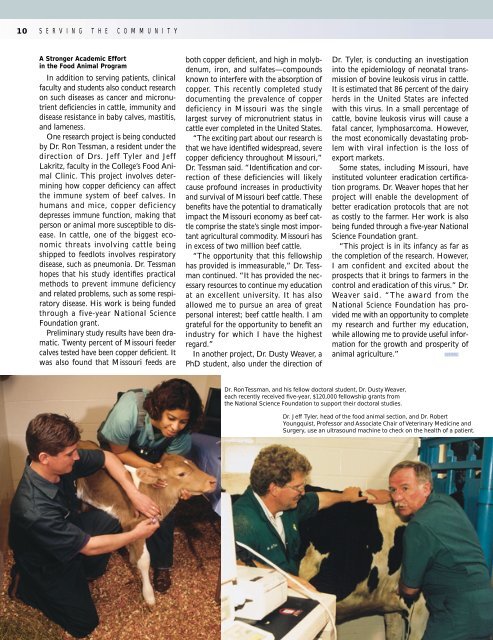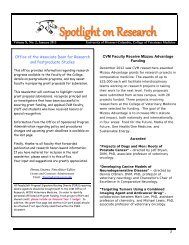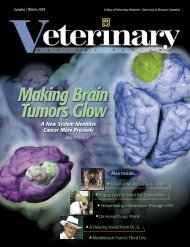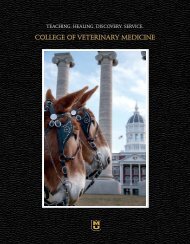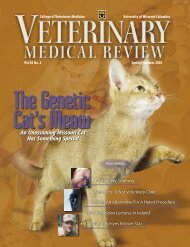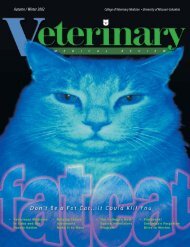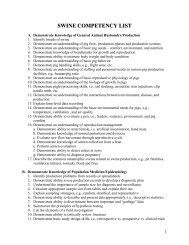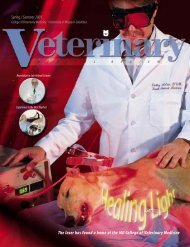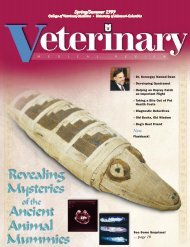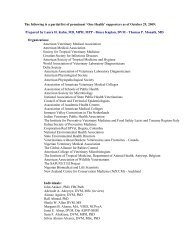Leading the Herd in North America - University of Missouri - College ...
Leading the Herd in North America - University of Missouri - College ...
Leading the Herd in North America - University of Missouri - College ...
Create successful ePaper yourself
Turn your PDF publications into a flip-book with our unique Google optimized e-Paper software.
10<br />
S E R V I N G T H E<br />
C O M M U N I T Y<br />
A Stronger Academic Effort<br />
<strong>in</strong> <strong>the</strong> Food Animal Program<br />
In addition to serv<strong>in</strong>g patients, cl<strong>in</strong>ical<br />
faculty and students also conduct research<br />
on such diseases as cancer and micronutrient<br />
deficiencies <strong>in</strong> cattle, immunity and<br />
disease resistance <strong>in</strong> baby calves, mastitis,<br />
and lameness.<br />
One research project is be<strong>in</strong>g conducted<br />
by Dr. Ron Tessman, a resident under <strong>the</strong><br />
direction <strong>of</strong> Drs. Jeff Tyler and Jeff<br />
Lakritz, faculty <strong>in</strong> <strong>the</strong> <strong>College</strong>’s Food Animal<br />
Cl<strong>in</strong>ic. This project <strong>in</strong>volves determ<strong>in</strong><strong>in</strong>g<br />
how copper deficiency can affect<br />
<strong>the</strong> immune system <strong>of</strong> beef calves. In<br />
humans and mice, copper deficiency<br />
depresses immune function, mak<strong>in</strong>g that<br />
person or animal more susceptible to disease.<br />
In cattle, one <strong>of</strong> <strong>the</strong> biggest economic<br />
threats <strong>in</strong>volv<strong>in</strong>g cattle be<strong>in</strong>g<br />
shipped to feedlots <strong>in</strong>volves respiratory<br />
disease, such as pneumonia. Dr. Tessman<br />
hopes that his study identifies practical<br />
methods to prevent immune deficiency<br />
and related problems, such as some respiratory<br />
disease. His work is be<strong>in</strong>g funded<br />
through a five-year National Science<br />
Foundation grant.<br />
Prelim<strong>in</strong>ary study results have been dramatic.<br />
Twenty percent <strong>of</strong> <strong>Missouri</strong> feeder<br />
calves tested have been copper deficient. It<br />
was also found that <strong>Missouri</strong> feeds are<br />
both copper deficient, and high <strong>in</strong> molybdenum,<br />
iron, and sulfates—compounds<br />
known to <strong>in</strong>terfere with <strong>the</strong> absorption <strong>of</strong><br />
copper. This recently completed study<br />
document<strong>in</strong>g <strong>the</strong> prevalence <strong>of</strong> copper<br />
deficiency <strong>in</strong> <strong>Missouri</strong> was <strong>the</strong> s<strong>in</strong>gle<br />
largest survey <strong>of</strong> micronutrient status <strong>in</strong><br />
cattle ever completed <strong>in</strong> <strong>the</strong> United States.<br />
“The excit<strong>in</strong>g part about our research is<br />
that we have identified widespread, severe<br />
copper deficiency throughout <strong>Missouri</strong>,”<br />
Dr. Tessman said. “Identification and correction<br />
<strong>of</strong> <strong>the</strong>se deficiencies will likely<br />
cause pr<strong>of</strong>ound <strong>in</strong>creases <strong>in</strong> productivity<br />
and survival <strong>of</strong> <strong>Missouri</strong> beef cattle. These<br />
benefits have <strong>the</strong> potential to dramatically<br />
impact <strong>the</strong> <strong>Missouri</strong> economy as beef cattle<br />
comprise <strong>the</strong> state’s s<strong>in</strong>gle most important<br />
agricultural commodity. <strong>Missouri</strong> has<br />
<strong>in</strong> excess <strong>of</strong> two million beef cattle.<br />
“The opportunity that this fellowship<br />
has provided is immeasurable,” Dr. Tessman<br />
cont<strong>in</strong>ued. “It has provided <strong>the</strong> necessary<br />
resources to cont<strong>in</strong>ue my education<br />
at an excellent university. It has also<br />
allowed me to pursue an area <strong>of</strong> great<br />
personal <strong>in</strong>terest; beef cattle health. I am<br />
grateful for <strong>the</strong> opportunity to benefit an<br />
<strong>in</strong>dustry for which I have <strong>the</strong> highest<br />
regard.”<br />
In ano<strong>the</strong>r project, Dr. Dusty Weaver, a<br />
PhD student, also under <strong>the</strong> direction <strong>of</strong><br />
Dr. Tyler, is conduct<strong>in</strong>g an <strong>in</strong>vestigation<br />
<strong>in</strong>to <strong>the</strong> epidemiology <strong>of</strong> neonatal transmission<br />
<strong>of</strong> bov<strong>in</strong>e leukosis virus <strong>in</strong> cattle.<br />
It is estimated that 86 percent <strong>of</strong> <strong>the</strong> dairy<br />
herds <strong>in</strong> <strong>the</strong> United States are <strong>in</strong>fected<br />
with this virus. In a small percentage <strong>of</strong><br />
cattle, bov<strong>in</strong>e leukosis virus will cause a<br />
fatal cancer, lymphosarcoma. However,<br />
<strong>the</strong> most economically devastat<strong>in</strong>g problem<br />
with viral <strong>in</strong>fection is <strong>the</strong> loss <strong>of</strong><br />
export markets.<br />
Some states, <strong>in</strong>clud<strong>in</strong>g <strong>Missouri</strong>, have<br />
<strong>in</strong>stituted volunteer eradication certification<br />
programs. Dr. Weaver hopes that her<br />
project will enable <strong>the</strong> development <strong>of</strong><br />
better eradication protocols that are not<br />
as costly to <strong>the</strong> farmer. Her work is also<br />
be<strong>in</strong>g funded through a five-year National<br />
Science Foundation grant.<br />
“This project is <strong>in</strong> its <strong>in</strong>fancy as far as<br />
<strong>the</strong> completion <strong>of</strong> <strong>the</strong> research. However,<br />
I am confident and excited about <strong>the</strong><br />
prospects that it br<strong>in</strong>gs to farmers <strong>in</strong> <strong>the</strong><br />
control and eradication <strong>of</strong> this virus.” Dr.<br />
Weaver said. “The award from <strong>the</strong><br />
National Science Foundation has provided<br />
me with an opportunity to complete<br />
my research and fur<strong>the</strong>r my education,<br />
while allow<strong>in</strong>g me to provide useful <strong>in</strong>formation<br />
for <strong>the</strong> growth and prosperity <strong>of</strong><br />
animal agriculture.”<br />
VMR<br />
Dr. Ron Tessman, and his fellow doctoral student, Dr. Dusty Weaver,<br />
each recently received five-year, $120,000 fellowship grants from<br />
<strong>the</strong> National Science Foundation to support <strong>the</strong>ir doctoral studies.<br />
Dr. Jeff Tyler, head <strong>of</strong> <strong>the</strong> food animal section, and Dr. Robert<br />
Youngquist, Pr<strong>of</strong>essor and Associate Chair <strong>of</strong> Veter<strong>in</strong>ary Medic<strong>in</strong>e and<br />
Surgery, use an ultrasound mach<strong>in</strong>e to check on <strong>the</strong> health <strong>of</strong> a patient.


